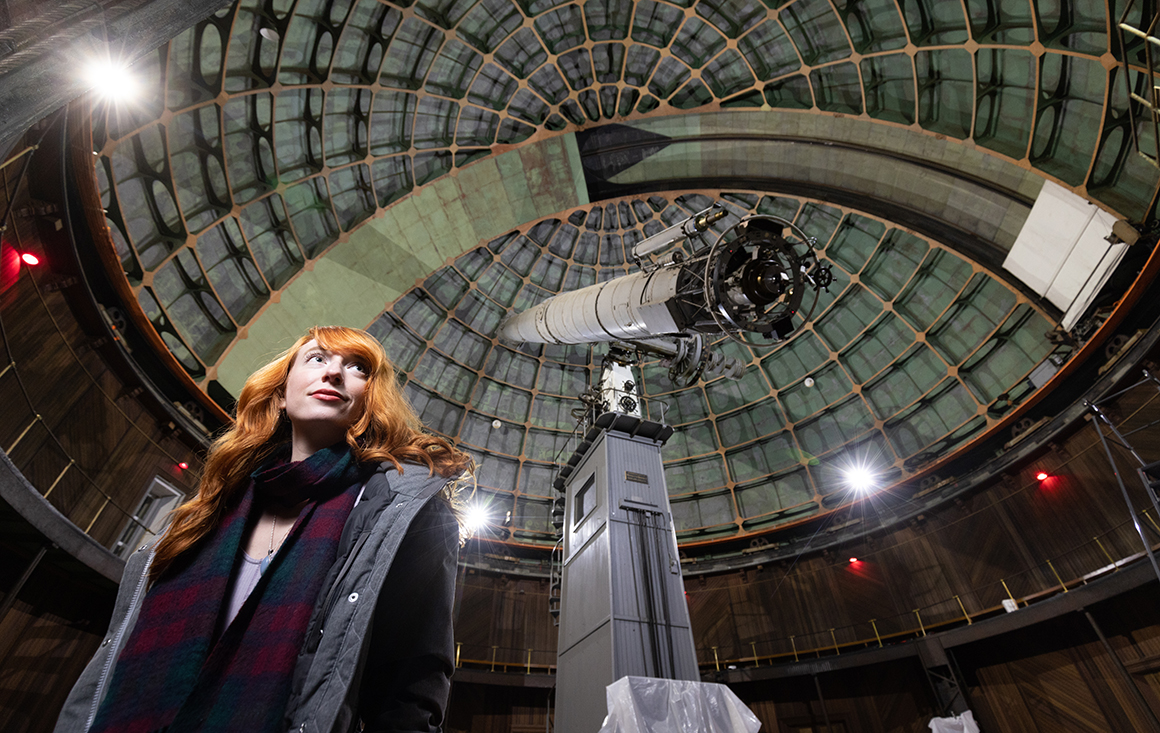Seeing Stars

Picture a clear, dark night—dark enough to see distant planets, hundreds of glittering stars, and the glorious band of our Milky Way Galaxy stretching from horizon to horizon. For most city dwellers, this awe-inspiring sight is an uncommon one due to the abundance of artificial lights across our streets and homes.
But what if we could restore these celestial views by darkening our driveways and sidewalks? Would you do it, even if it meant some mild inconvenience? And more importantly, do you have an ethical obligation to do so?
This question lies at the core of Assistant Professor Kimberly Dill’s philosophical research on dark sky conservation. In considering the holistic and ecological benefits of natural darkness, she argues that re-wilding the night sky isn’t just an aesthetic motivation but an ethical one. Thanks to funding from a Markkula Center Hackworth Grant, she’ll soon investigate how different dark sky sites across the world have been able to keep the lights off.
In thinking about the ethics of artificial lighting—it’s easy to point to the beauty of the unpolluted night sky as sufficient motivation to explore dark sky conservation. However, Dill’s ethical approach to this issue also considers the impact of true darkness on human health and the health of our biodiverse planet.
“Being connected to the stars can evoke so many transformative emotions,” explains Dill. “When we cut ourselves off from these experiences, we see increases in mental health disorders like depression and anxiety. Without awe and wonder, people find it difficult to move beyond the bounds of the self.” The blue artificial lights often used at night have also been linked to disrupted Circadian rhythms and increased cancer rates—impacting physiological health as well.
You can see similar implications in the animal kingdom, Dill says, where darkness is a necessity for nocturnal animals like bats, moths, coyotes, and foxes. Because artificial night lighting negatively impacts their migration and pollination, there’s a cascading ecological effect in the greater “more-than-human world” of flora, fauna, and their holistic environments—all tied to the simple act of turning on a city street lamp.
“The human and more-than-human worlds are entangled in these very rich and deep ways,” she says. “I see my work as making those connections a lot more explicit.”
By demonstrating this interconnected relationship, she hopes to highlight the ethical urgency of preserving darkness where it already exists—and going the extra step to remove artificial lights through policies that would restore natural darkness, or “re-wild” the night sky.
Changing policy is never easy; strategies would vary with every location’s unique cultural and economic realities. So, with the funds from her Hackworth Grant, Dill will visit three international dark sky sites to better understand how conservation policy tensions were resolved locally. She plans to visit Alqueva, Portugal, Galloway Forest Park, Scotland, and Bryce Canyon National Park, U.S. to learn from diverse conservationists.
By researching a multiplicity of contexts, Dill aims to highlight a Jain philosophical value called anekantavada, meaning ‘many-sidedness.’ “If you want to get a complete picture of a complex issue, learn as much as you can about as many diverse worldviews as you can,” she explains. “Then, see where they overlap and draw your own conclusions.”

Light pollution can threaten the astronomical research done at nearby Lick Observatory, says Dill
It's Dill’s hope that her comparative research opens up more nuanced discussions about dark sky conservation efforts and how their implementation will differ between the Global North—e.g., America—and the Global South—e.g., Africa and India. At the same time, she knows changing the world starts in our own backyard.
So, how can the average person living in urban, technologically driven communities like Silicon Valley contribute to re-wilding efforts? Dill recommends using motion-activated lighting and low-pressure sodium bulbs to positively impact humans, animals, and the environment.
But her vision doesn’t stop there. She’s also an advocate for more creative, bioluminescent solutions, like developing sustainable, kinetically-driven urban lighting that harnesses the footfalls or touches of passersby to shake up photoluminescent algae and bacteria. With each step, a city would be lit by gentle blues and glowing greens.
While this may sound like science fiction, teaching in the heart of Silicon Valley has convinced Dill that with the right technological innovation, it’s possible to incorporate beauty and sustainability into urban planning without sacrificing efficacy. And in the case of less technology-driven solutions, she acknowledges that we will have to use that same innovative mindset to actually imagine different ways of living.
Re-wilding the night sky is a large undertaking, one that can sometimes feel as distant as the stars themselves, but Dill believes that everyday people can do a lot. “If you pay close attention to the more-than-human world, that attention will motivate care.”
Get started
For those inspired by her conservation work, Dill recommends supporting local dark sky conservation efforts led by nearby Lick Observatory, or getting involved at SCU’s Forge Garden.
Read more
Braiding Sweetgrass by Robin Wall Kimmerer
The End of Night by Paul Bogard
The mission of the Markkula Center for Applied Ethics is to engage individuals and organizations in making choices that respect and care for others.